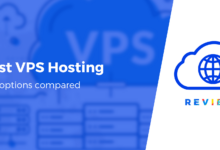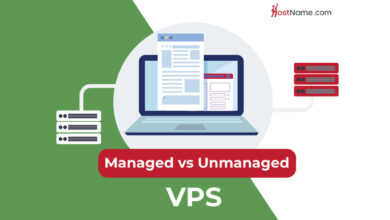10 Common VPS Hosting Mistakes and How to Avoid Them
10 Common VPS Hosting Mistakes and How to Avoid Them: Navigating the world of Virtual Private Servers (VPS) can feel overwhelming, especially for those new to web hosting. Understanding common pitfalls is crucial for ensuring optimal website performance, security, and scalability. This guide delves into ten frequent mistakes, offering practical advice and solutions to help you avoid costly errors and maximize your VPS experience. From selecting the right provider to implementing robust security measures and monitoring performance effectively, we’ll cover essential aspects to guarantee a smooth and successful hosting journey.
This comprehensive guide aims to empower you with the knowledge and strategies necessary to make informed decisions regarding your VPS hosting. By understanding the potential challenges and proactively implementing preventative measures, you can significantly reduce the risk of encountering common issues and ensure your website operates efficiently and securely.
Choosing the Wrong VPS Provider
Selecting the appropriate Virtual Private Server (VPS) provider is crucial for the success of your online project. A poorly chosen provider can lead to performance issues, downtime, and ultimately, financial losses. Understanding the key factors involved in selecting a reliable provider and the potential consequences of making the wrong choice is essential for any business or individual deploying applications or websites on a VPS.
VPS Provider Comparison
Choosing the right VPS provider requires careful consideration of several factors. The following table compares four popular VPS providers, highlighting key features and pricing. Note that pricing can vary significantly based on server specifications and location. This table presents a snapshot in time and should be verified with the provider’s current pricing information.
| Provider | Key Features | Pricing (example – starting price) | Location Options |
|---|---|---|---|
| DigitalOcean | Simple interface, easy management, strong community support, various OS options. | $5/month | Multiple global data centers. |
| Vultr | High performance, various server types (high-frequency, cloud compute), competitive pricing. | $2.50/month | Many global data centers. |
| Linode | Reliable infrastructure, robust API, excellent support, various server sizes and configurations. | $5/month | Multiple global data centers. |
| AWS (Amazon Web Services) – EC2 | Extensive features, scalability, pay-as-you-go model, wide range of services. More complex to manage. | Variable, depending on instance type and usage. | Numerous global regions and availability zones. |
Criteria for Selecting a Reliable VPS Provider
Several key criteria should guide your decision when choosing a VPS provider. These criteria ensure the chosen provider meets your performance, security, and support needs.
Firstly, uptime guarantee is paramount. A high uptime percentage (ideally 99.9% or higher) indicates a provider’s commitment to minimizing downtime. Secondly, bandwidth and storage should be sufficient for your anticipated needs. Consider factors like website traffic and data storage requirements when making this assessment. Thirdly, customer support is crucial. Look for providers that offer 24/7 support through multiple channels (e.g., email, phone, live chat). Fourthly, security measures are essential. A reliable provider will implement robust security protocols to protect your data and infrastructure. Finally, pricing and scalability should be considered. Choose a provider that offers transparent pricing and the ability to easily scale your resources as your needs evolve.
Consequences of Choosing an Unreliable Provider
Selecting an unreliable VPS provider can have several detrimental consequences. These consequences can range from minor inconveniences to significant financial losses and reputational damage.
Firstly, frequent downtime can severely impact your website’s availability and negatively affect user experience. This can lead to lost sales and damage to your brand’s reputation. Secondly, poor performance due to inadequate resources or infrastructure can result in slow loading times, impacting user engagement and search engine rankings. Thirdly, security vulnerabilities from a provider with weak security measures can expose your data to cyber threats, leading to data breaches and financial losses. Fourthly, lack of adequate support can leave you struggling to resolve technical issues, leading to extended downtime and frustration. Finally, hidden costs and unexpected price increases can strain your budget and negatively impact your project’s financial viability. For example, a provider might offer a low initial price but charge exorbitant fees for essential features or support.
Insufficient Resources
Choosing the right amount of VPS resources is crucial for optimal website performance and a positive user experience. Underestimating your needs can lead to significant problems, impacting everything from website speed to overall functionality. Accurately assessing your resource requirements is a critical step in avoiding costly mistakes and ensuring your website runs smoothly.
The core resources you need to consider are RAM (Random Access Memory), CPU (Central Processing Unit), and storage space. RAM is essential for handling active processes, CPU power determines processing speed, and storage space dictates how much data your website can hold. Failing to allocate sufficient resources in any of these areas can severely impact your website’s performance and user experience.
Determining Required VPS Resources
A systematic approach is needed to determine the appropriate VPS resources. The following flowchart illustrates a step-by-step process for assessing your needs.
Flowchart: Determining Required VPS Resources
Start → Assess Website Traffic (Current and Projected) → Analyze Website Functionality (Database size, applications, multimedia content) → Estimate Resource Usage (RAM, CPU, Storage) → Choose VPS Plan (Based on estimated resource needs, considering scalability) → Monitor Performance (Track resource usage and adjust plan as needed) → End
Impact of Insufficient Resources on Website Performance
Insufficient resources directly translate to noticeable performance issues. For example, inadequate RAM can lead to slow loading times, application crashes, and an overall sluggish user experience. A website with insufficient RAM might struggle to handle multiple concurrent users, resulting in frustrating delays and potentially lost customers. Similarly, insufficient CPU power can result in slow processing speeds, impacting everything from page rendering to database queries. This can manifest as long load times, unresponsive pages, and ultimately, a negative impact on your search engine rankings. Finally, insufficient storage space can lead to website downtime, inability to upload new content, and potential data loss. A website that runs out of storage space simply stops functioning correctly.
Consider a popular e-commerce site experiencing a sudden surge in traffic during a holiday sale. If the VPS hosting plan doesn’t have enough RAM to handle the increased number of concurrent users, the site will likely become slow and unresponsive, leading to lost sales and frustrated customers. This scenario highlights the importance of accurately predicting resource needs and choosing a scalable VPS plan that can accommodate fluctuations in traffic.
Neglecting Security
A Virtual Private Server (VPS) offers significant control and flexibility, but this freedom comes with heightened responsibility for security. Failing to implement robust security measures can expose your VPS to various threats, leading to data breaches, financial losses, and reputational damage. Prioritizing security from the outset is crucial for maintaining the integrity and functionality of your VPS.
Essential Security Measures for VPS Hosting
A proactive approach to security involves implementing a comprehensive set of measures. Regularly reviewing and updating these measures is vital to maintain the effectiveness of your security posture against evolving threats.
- Strong Passwords and Password Management: Employ unique, complex passwords for all accounts (root, user, database, etc.), and consider using a password manager to securely store and manage them. A strong password should include a mix of uppercase and lowercase letters, numbers, and symbols, and should be at least 12 characters long.
- Regular Software Updates: Keep your operating system, applications, and all software components up-to-date with the latest security patches. Outdated software is a prime target for attackers.
- Firewall Configuration: Implement a robust firewall to control network traffic, allowing only necessary connections while blocking all others. This prevents unauthorized access to your server.
- Regular Security Audits and Vulnerability Scanning: Conduct regular security audits and vulnerability scans to identify and address potential weaknesses in your system’s security. Many tools are available to automate this process.
- Intrusion Detection and Prevention Systems (IDS/IPS): Deploy an IDS/IPS to monitor network traffic for malicious activity and take appropriate action to prevent attacks. These systems can alert you to suspicious behavior and automatically block harmful traffic.
- Regular Backups: Regularly back up your data to a secure, offsite location. This ensures data recovery in case of a security breach or other unforeseen events. Consider using a reputable cloud storage provider or a separate physical backup device.
- SSH Key Authentication: Disable password-based SSH login and use SSH key authentication instead. This provides a more secure way to access your VPS remotely.
- Security Hardening: Implement security hardening techniques to reduce the attack surface of your VPS. This includes disabling unnecessary services, removing default accounts, and restricting access to sensitive files and directories.
Firewall Setup and Strong Password Implementation
Setting up a firewall involves configuring rules to allow or deny network traffic based on source IP address, port number, and protocol. Most VPS providers offer firewall management tools through their control panels. These tools typically allow you to create custom rules to define which services are accessible from the internet and which are blocked. For example, you might allow SSH access only from your personal IP address and block all other incoming connections on port 22. A well-configured firewall is your first line of defense against many attacks.
Strong passwords should be unique and difficult to guess. Avoid using easily guessable information like birthdays, pet names, or common words. Instead, use a combination of uppercase and lowercase letters, numbers, and symbols, and aim for a length of at least 12 characters. Using a password manager is highly recommended for securely storing and managing your passwords across multiple accounts.
Risks of Neglecting Security and Potential Consequences
Neglecting security measures on your VPS exposes you to significant risks, including data breaches, malware infections, denial-of-service attacks, and unauthorized access. A data breach can lead to the loss of sensitive customer information, financial losses, and reputational damage. Malware infections can compromise your system’s performance and potentially spread to other systems. Denial-of-service attacks can render your VPS inaccessible to legitimate users. Unauthorized access can result in data theft, system modification, and other malicious activities. The consequences can be severe, impacting your business operations, financial stability, and overall reputation. The costs associated with remediation, legal fees, and reputational damage can far outweigh the investment in proactive security measures.
Ignoring Regular Backups
Data loss is a significant threat to any VPS, regardless of size or purpose. Regular backups are crucial for business continuity and disaster recovery, providing a safety net against accidental deletions, hardware failures, malware attacks, and other unforeseen events. Failing to implement a robust backup strategy can lead to irreversible data loss and significant financial consequences.
Regular backups safeguard your valuable data, ensuring you can quickly recover from unexpected incidents. This involves understanding different backup types and establishing a well-defined backup and retention schedule. A comprehensive backup strategy is an essential component of a robust VPS management plan.
Backup Types
Different backup methods offer varying levels of efficiency and recovery time. Understanding these differences is vital for choosing the right strategy for your needs. Full backups create a complete copy of your data, while incremental and differential backups only copy changes since the last backup, saving storage space and time.
- Full Backup: A complete copy of all data at a specific point in time. This is the most time-consuming but provides the most comprehensive recovery option. It serves as the foundation for other backup types.
- Incremental Backup: Copies only the data that has changed since the last full or incremental backup. This is efficient in terms of storage space and backup time, but restoring data requires the full backup and all subsequent incremental backups.
- Differential Backup: Copies all data that has changed since the last full backup. This method requires less storage space than a full backup and restores faster than incremental backups because it only needs the full backup and the most recent differential backup.
Backup Schedule and Retention Policy
Establishing a regular backup schedule and a retention policy is paramount. The frequency depends on the rate of data changes and the criticality of the data. A retention policy defines how long backups are stored.
A sample schedule could be:
- Daily Full Backup: Performed once a day, typically during off-peak hours, to provide a complete snapshot of your data.
- Weekly Incremental Backups: Performed six days a week, copying only the changes since the last full or incremental backup. This reduces storage space and backup time significantly.
- Monthly Differential Backups: Performed once a month, capturing changes since the last full backup. This provides an additional layer of protection and a faster restore process than incremental backups.
Retention policy could be:
- Keep the last 7 daily incremental backups.
- Keep the last 4 weekly full backups.
- Keep the last 12 monthly differential backups.
This ensures you have sufficient backups to recover from most incidents while managing storage space effectively. Adjust this schedule and policy based on your specific data requirements and risk tolerance. Consider offsite storage for added protection against physical disasters.
Data Restoration from Backup
Restoring data from a backup involves several steps. The exact process depends on the backup software and type of backup used. Generally, it involves accessing the backup, selecting the data to restore, and specifying the restoration location. Testing the restoration process regularly is crucial to ensure its effectiveness and identify potential issues before a real disaster strikes. A successful test restoration builds confidence and minimizes downtime during a real data loss event.
Failing to Monitor Performance
Regularly monitoring your VPS performance is crucial for maintaining optimal functionality and preventing unexpected downtime. Ignoring performance indicators can lead to slow loading times, application errors, and ultimately, a negative impact on your business or project. Proactive monitoring allows for early detection of issues, enabling timely intervention and preventing escalation.
Effective VPS performance monitoring involves tracking key metrics to identify potential bottlenecks and ensure your server resources are being utilized efficiently. This proactive approach minimizes downtime, improves user experience, and safeguards your investment.
Key Performance Indicators (KPIs) for VPS Monitoring
Several key performance indicators are essential for comprehensive VPS monitoring. Tracking these metrics provides a holistic view of your server’s health and performance.
- CPU Usage: Monitoring CPU usage reveals how heavily your server’s processor is working. High and sustained CPU usage indicates a potential bottleneck, suggesting the need for resource upgrades or application optimization.
- RAM Usage: Tracking RAM usage shows how much memory your applications and processes are consuming. Consistent high RAM usage can lead to slowdowns and crashes, requiring additional RAM allocation or application adjustments.
- Disk I/O: Monitoring disk input/output (I/O) operations reveals the efficiency of your storage system. High disk I/O indicates potential bottlenecks that can impact application performance and database operations.
- Network Traffic: Tracking network traffic, both inbound and outbound, provides insights into data transfer rates and potential congestion issues. High network traffic can impact website loading times and application responsiveness.
- Uptime: Tracking server uptime is crucial for ensuring service availability. Frequent downtime indicates underlying issues requiring immediate attention and resolution.
Methods for Tracking Resource Usage and Identifying Bottlenecks
Several tools and techniques are available to effectively track resource usage and pinpoint performance bottlenecks. Choosing the right method depends on your technical expertise and the complexity of your VPS setup.
- Control Panel Monitoring: Most VPS control panels (e.g., cPanel, Plesk) provide built-in monitoring tools that display real-time resource usage. These tools often provide graphical representations of CPU, RAM, and disk I/O usage, making it easy to identify trends and potential problems.
- Command-Line Tools: For more granular control and detailed information, command-line tools like
top,htop,iostat, andnetstatcan be used to monitor resource usage in real-time. These tools provide detailed information about individual processes and system resources. - Third-Party Monitoring Services: Services like Datadog, Nagios, and Zabbix offer comprehensive monitoring capabilities, providing alerts and detailed reports on various aspects of your VPS performance. These services often integrate with multiple platforms and offer advanced features such as automated alerts and customizable dashboards.
Actions to Take When Performance Issues Arise
Once performance issues are identified, prompt action is crucial to minimize disruption and maintain optimal functionality. The appropriate response will depend on the nature and severity of the problem.
- Identify the Bottleneck: Determine the specific resource causing the performance issue (e.g., high CPU usage, low disk space). This step is crucial for targeted problem-solving.
- Optimize Applications: Inefficiently coded applications can consume excessive resources. Optimizing your applications, such as database queries or code refactoring, can significantly improve performance.
- Upgrade Resources: If resource constraints are the cause, consider upgrading your VPS plan to allocate more CPU, RAM, or storage. This is often the most straightforward solution for performance issues caused by resource limitations.
- Implement Caching: Caching frequently accessed data can significantly reduce server load and improve response times. Various caching mechanisms are available, depending on your application and infrastructure.
- Investigate and Resolve Errors: Thoroughly investigate any error messages or logs to identify and resolve underlying issues that may be contributing to performance problems. This involves careful examination of system logs and application logs to pinpoint the source of the problem.
Improper Server Configuration
A well-configured VPS server is the cornerstone of optimal performance and robust security. Neglecting proper configuration can lead to vulnerabilities, slowdowns, and ultimately, system instability. This section details best practices to ensure your VPS operates efficiently and securely.
Proper server configuration involves a multifaceted approach encompassing security hardening, performance optimization, and diligent maintenance. Failing to address these aspects can leave your server exposed to attacks and hinder its ability to deliver the performance you need. This includes choosing the right operating system, configuring the firewall effectively, and optimizing resource allocation.
Operating System Selection and Initial Setup
The choice of operating system significantly impacts your VPS’s security and performance. Distributions like Ubuntu Server or CentOS are popular choices due to their robust security features, extensive community support, and readily available resources. During initial setup, carefully consider the essential services you require and disable any unnecessary ones to minimize attack surfaces. This also contributes to improved resource utilization. A minimal installation, followed by the strategic addition of only necessary packages, is a best practice.
Firewall Configuration
A correctly configured firewall is crucial for preventing unauthorized access to your server. The firewall should be set up to allow only necessary inbound and outbound traffic. For instance, only open ports required for specific applications (like SSH for remote access, or the port for your web server) and block all others. Regularly review and update your firewall rules to reflect changes in your server’s configuration and security needs. Employing a stateful firewall, which tracks network connections, provides an added layer of security.
Security Hardening
Security hardening involves implementing various measures to minimize vulnerabilities. This includes regularly updating the operating system and all installed software, using strong and unique passwords, disabling unnecessary services, and regularly reviewing system logs for suspicious activity. Enabling SSH key-based authentication instead of password-based authentication is a significant security enhancement, eliminating the risk of brute-force attacks. Furthermore, limiting the number of login attempts and configuring fail2ban to automatically block IP addresses after multiple failed login attempts significantly strengthens security.
Regular Updates and Patching
Regularly updating the operating system and all installed software is paramount for maintaining security. Updates often include critical security patches that address known vulnerabilities. Employing an automated update system, where possible, ensures that your server is consistently protected against the latest threats. Ignoring updates leaves your system exposed to exploits that can compromise your data and the integrity of your server. It’s important to test updates in a non-production environment before deploying them to a live server to avoid unforeseen issues.
Performance Optimization
Optimizing your VPS for performance involves several steps. This includes ensuring sufficient RAM and processing power, selecting the appropriate storage type (SSD is generally recommended for faster performance), and optimizing database queries. Regularly monitoring resource usage allows for proactive identification of bottlenecks and potential performance issues. Utilizing tools to analyze server logs and identify areas for improvement can help fine-tune your server’s configuration for optimal efficiency. Consider using caching mechanisms to reduce the load on your server and improve response times.
Overlooking Scalability
Ensuring your VPS can handle increasing demands is crucial for sustained performance and business growth. Failing to plan for scalability can lead to slowdowns, downtime, and ultimately, lost revenue. Understanding your scaling options and proactively addressing potential challenges is essential for a robust and resilient VPS infrastructure.
Understanding the different ways to scale your VPS is paramount to avoid performance bottlenecks as your website or application gains popularity. Two primary approaches exist: vertical and horizontal scaling. Choosing the right method depends on your specific needs and resources.
Vertical Scaling
Vertical scaling, also known as scaling up, involves increasing the resources of your existing VPS. This might include upgrading to a VPS with more RAM, a faster processor, or more storage space. This approach is simpler to implement than horizontal scaling, as it only requires upgrading your current server. However, there’s a limit to how much you can scale vertically before hitting the hardware limitations of a single server. For instance, you can’t indefinitely increase the RAM or processing power of a single machine. This approach is generally cost-effective for smaller increases in demand, but can become prohibitively expensive at higher scales.
Horizontal Scaling
Horizontal scaling, or scaling out, involves adding more servers to your infrastructure. Instead of upgrading a single server, you add additional VPS instances to distribute the workload. This approach offers greater scalability and resilience. If one server fails, the others can continue to operate, minimizing downtime. Horizontal scaling is particularly well-suited for applications that can be easily distributed across multiple servers, such as those using load balancers to distribute traffic. While initially more complex to set up than vertical scaling, it offers far greater flexibility and potential for growth. For example, a rapidly growing e-commerce site might initially start with a single VPS, then scale horizontally by adding additional servers to handle peak traffic during sales events. This ensures the site remains responsive and avoids crashes even under heavy load.
Challenges of Scaling and Mitigation Strategies
Scaling, whether vertically or horizontally, presents certain challenges. One common issue is the potential for increased complexity in managing a larger infrastructure. With multiple servers, configuration management and monitoring become more involved. To mitigate this, consider using automation tools like Ansible or Puppet for configuration management, and centralized monitoring systems like Nagios or Zabbix to track server performance and resource utilization. Another challenge is the cost. Scaling, particularly horizontally, can significantly increase your hosting expenses. Careful planning and resource optimization are crucial to control costs. Regularly reviewing your resource utilization and right-sizing your servers can help minimize unnecessary expenditure. Finally, network latency can become a concern with horizontal scaling, especially if your servers are geographically dispersed. Using a Content Delivery Network (CDN) can help mitigate this by caching static content closer to your users.
Ignoring Software Updates
Outdated software represents a significant vulnerability in your VPS environment. Regular updates are crucial for maintaining the security and stability of your server, preventing performance issues, and ensuring compatibility with other systems. Neglecting these updates exposes your server to potential exploits and compromises, leading to data breaches, downtime, and financial losses.
Regular updates patch security vulnerabilities, improve performance, and introduce new features. Failing to apply these updates leaves your system susceptible to known exploits, potentially allowing malicious actors to gain unauthorized access, install malware, or disrupt your services. This can lead to significant financial and reputational damage.
Vulnerabilities of Outdated Software
Running outdated software exposes your VPS to a range of serious vulnerabilities. These vulnerabilities are often publicly known, allowing attackers to easily exploit weaknesses in the code. For example, an outdated operating system might have a known security flaw that allows remote code execution, granting an attacker complete control of your server. Similarly, outdated applications may contain vulnerabilities that can be used to steal data, install ransomware, or launch denial-of-service attacks. The longer outdated software remains on your system, the greater the risk becomes. The consequences of a successful attack can range from minor inconveniences to catastrophic data loss and business disruption. The cost of remediation after a breach can far exceed the time and effort required for regular updates.
Planning for Regular Updates
A proactive approach to software updates is essential for minimizing downtime and maintaining a secure VPS. A well-defined update plan should include several key components. First, establish a regular schedule for updates. This could involve applying updates weekly, bi-weekly, or monthly, depending on the criticality of your applications and the frequency of releases. Second, test updates in a staging environment before applying them to your production server. This allows you to identify and resolve any potential compatibility issues or unexpected behavior before they affect your live system. Third, prioritize updates based on their criticality. Security patches should always be prioritized, followed by performance improvements and new features. Fourth, utilize automated update tools where possible. Many operating systems and applications offer automated update mechanisms that simplify the process and minimize manual intervention. Fifth, monitor your system after applying updates to ensure everything is functioning correctly. This proactive approach will help you to swiftly identify and address any issues that may arise. Finally, document your update procedures and maintain a record of all updates applied. This will aid in troubleshooting and auditing.
Neglecting Network Security
A VPS, while offering greater control than shared hosting, also presents increased responsibility for network security. Failing to adequately secure your VPS exposes it to a range of threats, potentially leading to data breaches, service disruptions, and financial losses. Implementing robust security measures is crucial for maintaining the integrity and availability of your VPS.
Network security threats targeting VPS servers are diverse and constantly evolving. Common vulnerabilities include Distributed Denial-of-Service (DDoS) attacks, unauthorized access attempts via brute-force password cracking, malware infections spread through vulnerabilities in outdated software, and man-in-the-middle attacks intercepting sensitive data.
Firewall Rules and Configurations
A well-configured firewall is the first line of defense against many network attacks. It acts as a gatekeeper, controlling incoming and outgoing network traffic based on predefined rules. Strong firewall rules should restrict access to only necessary ports and services. For example, only allow SSH access from specific IP addresses or ranges known to be trusted. Similarly, if your application doesn’t require HTTP port 80, block it. Allowing unnecessary ports increases your attack surface. A robust configuration might include:
- Allowing SSH access only from your known IP addresses on a non-standard port (e.g., port 2222 instead of the default 22).
- Blocking all incoming connections on ports commonly associated with known vulnerabilities (e.g., ports 135, 139, 445 for older versions of Windows).
- Enabling stateful inspection to track the context of network connections, preventing unauthorized connections that appear legitimate.
Beyond basic port blocking, consider using advanced firewall features such as intrusion detection and prevention systems (IDS/IPS) to actively monitor network traffic for malicious activity and automatically block suspicious connections. This adds an extra layer of security beyond simple access control.
Detecting and Responding to Network Attacks
Regularly monitoring your VPS for suspicious activity is essential for early detection of attacks. This involves monitoring logs for unusual login attempts, high traffic volumes, or unexpected network connections. Utilize tools such as intrusion detection systems (IDS) to analyze network traffic for patterns indicative of malicious activity. These systems can alert you to potential threats in real time.
In the event of a network attack, a swift and decisive response is critical to minimize damage. This might involve temporarily blocking suspicious IP addresses, isolating the affected server from the network, and investigating the root cause of the attack. Having a well-defined incident response plan in place beforehand significantly improves your ability to handle such situations effectively. This plan should include steps for data recovery, system restoration, and post-incident analysis to prevent future attacks. For example, if a DDoS attack is detected, implementing rate limiting on the firewall and contacting your hosting provider for assistance are crucial steps.
Lack of Proper Monitoring Tools
Effective monitoring is crucial for maintaining a healthy and performant VPS. Without proper tools, identifying and resolving issues can become significantly delayed, leading to downtime, performance degradation, and ultimately, impacting your business or project. Choosing and implementing the right monitoring tools proactively prevents these problems and allows for timely intervention.
Proper monitoring provides real-time insights into your VPS’s performance, resource utilization, and security. This allows for proactive problem-solving, preventing minor issues from escalating into major outages. By understanding your VPS’s behavior, you can optimize its performance, predict potential bottlenecks, and ensure continuous operation.
Essential Monitoring Tools for VPS Hosting
A comprehensive monitoring strategy requires a multi-faceted approach, utilizing tools that cover various aspects of your VPS’s operation. These tools can range from simple command-line utilities to sophisticated, cloud-based solutions. The best choice depends on your technical expertise, budget, and the complexity of your VPS setup.
Comparison of Monitoring Tools and Their Capabilities
Several monitoring tools cater to different needs and budgets. For example, Nagios is a widely-used, open-source monitoring system offering extensive customization and scalability. It allows for the monitoring of various metrics, including CPU usage, memory consumption, disk space, and network traffic. Alternatively, Zabbix, another open-source option, provides a similar feature set with a user-friendly interface. Cloud-based solutions like Datadog and Prometheus offer more automated features, advanced analytics, and integration with other services. Datadog, for instance, excels in its ease of use and comprehensive dashboards, while Prometheus is favored for its powerful querying capabilities and flexibility. The selection ultimately hinges on factors like the required level of customization, integration needs, and the level of technical expertise within your team.
Interpreting Monitoring Data and Identifying Potential Issues
Interpreting monitoring data requires understanding the key metrics and their typical ranges. High CPU utilization, for instance, might indicate a resource-intensive process or a poorly optimized application. Similarly, consistently high memory usage could point to a memory leak or the need for more RAM. High disk I/O could signal a bottleneck in data storage, potentially requiring an upgrade to faster storage. Anomalous network traffic might indicate a security breach or a denial-of-service attack. By correlating various metrics, you can pinpoint the root cause of performance issues. For example, a sudden spike in CPU usage accompanied by increased network traffic might suggest a DDoS attack. Regularly reviewing monitoring data and setting up alerts for critical thresholds allows for proactive issue resolution, preventing minor problems from escalating into major outages. Understanding typical baseline performance levels for your VPS is crucial for identifying deviations that signal potential issues.
Ignoring Technical Support
A reliable VPS hosting provider offers more than just server space; they provide crucial technical support to help navigate challenges and ensure smooth operation. Overlooking this readily available resource can significantly impact uptime, performance, and your overall experience. Proactive engagement with support can prevent minor issues from escalating into major disruptions.
Effective communication with technical support is key to resolving issues swiftly and efficiently. Clearly articulating the problem, providing relevant details, and actively participating in troubleshooting steps are vital for a positive outcome. A well-documented history of your interactions with support can also be invaluable for future reference.
Effective Communication Strategies
Before contacting support, gather all relevant information. This includes error messages, screenshots, logs, and the steps you’ve already taken to troubleshoot the problem. Clearly explain the issue, its impact, and the desired outcome. Use precise language and avoid technical jargon unless you’re certain the support representative understands it. Be patient and polite, even if the problem is frustrating. Follow the support representative’s instructions carefully, and provide feedback on the effectiveness of their suggestions. If the issue isn’t resolved, request escalation to a senior technician or manager.
Common Support Issues and Solutions
Several common issues benefit from prompt technical support intervention. For instance, if your VPS experiences unexpected downtime, immediately contact support to investigate the cause. Provide them with the exact time of the outage, any error messages you received, and the impact on your services. Similarly, if you’re struggling with server configuration, seeking assistance from experienced support engineers can prevent hours of wasted effort and potential misconfigurations. Support can guide you through complex procedures, ensuring optimal settings. Finally, if you encounter unexpected spikes in resource usage, support can help identify the cause—whether it’s a malicious script, a poorly coded application, or a simple configuration oversight. They can provide insights into optimizing resource allocation to prevent future occurrences.
End of Discussion
Mastering VPS hosting requires a proactive approach, combining careful planning with ongoing vigilance. By avoiding the ten common mistakes outlined in this guide, you can significantly improve your website’s performance, security, and overall stability. Remember that continuous monitoring, regular updates, and a well-defined strategy for scaling your resources are key to long-term success. Embrace these best practices, and your VPS journey will be characterized by efficiency, reliability, and peace of mind.









